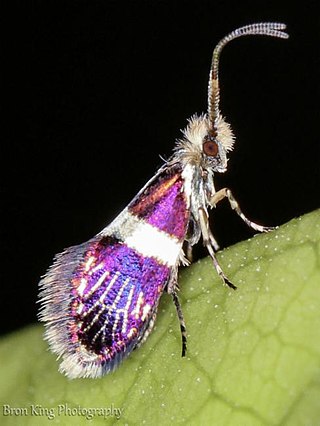
Lophocoronoidea is a superfamily of insects in the order Lepidoptera. There is a single extant genus, Lophocorona, in the family Lophocoronidae. These are small, primitive nocturnal moths restricted to Australia whose biology is largely unknown.
Agathiphaga is a genus of moths, known as kauri moths. and is the only living genus in the family Agathiphagidae. This caddisfly-like lineage of primitive moths was first reported by Lionel Jack Dumbleton in 1952, as a new genus of Micropterigidae.

Micropterix tunbergella is a moth of the family Micropterigidae found in most of Europe. The moths are very small and can be found feeding on the pollen of hawthorn, oak and sycamore. The larva and pupa are unknown. The moth was described Johan Christian Fabricius in 1787.
Micropterix fenestrellensis is a species of moth belonging to the family Micropterigidae. It was described by John Heath and T. Kaltenbach in 1984. It is known from Italy.
Austromartyria is a genus of small primitive metallic moths in the family Micropterigidae, with a single species.
Tasmantrix is a genus of small primitive metallic moths in the family Micropterigidae.

Zealandopterix is a genus of small primitive metallic moths in the family Micropterigidae.
Aureopterix is a genus of small primitive metallic moths in the family Micropterigidae.
Nannopterix is a genus of small primitive metallic moths in the family Micropterigidae.
Austromartyria porphyrodes is a moth of the family Micropterigidae. It is only known to be from the higher rainfall regions of the Atherton Tableland in northern Queensland.

Tasmantrix calliplaca is a moth of the Micropterigidae family. It is known from eastern Australia, in coastal rainforest from Finch Hatton Gorge, Eungella Range in Queensland to Elizabeth Beach in New South Wales.
Tasmantrix lunaris is a moth of the family Micropterigidae. It is known from eastern Australia, where it is known from two localities in the southern coastal forests of New South Wales.

Tasmantrix nigrocornis is a moth of the family Micropterigidae. It is known from eastern Australia, in coastal rainforests of southern New South Wales from Mount Keira to Mount Dromedary.
Tasmantrix phalaros is a moth of the family Micropterigidae. It is known from eastern Australia, in wet, upland eucalypt forests of northern New South Wales from Minyon Falls to Narara.
Tasmantrix tasmaniensis is a moth of the family Micropterigidae. It is known from in wet forests of western Tasmania.
Tasmantrix thula is a moth of the family Micropterigidae. It is known from eastern Australia, where it is known from northern Queensland, from Devils Thumb and Mossman Gorge in the north to Mission Beach and from Herberton State Forest to Mission beach.
Aureopterix micans is a moth of the family Micropterigidae. It is known from dense rainforest throughout New Caledonia from Mount Panié to the Rivière Bleue.
Aureopterix sterops is a moth of the family Micropterigidae. It is known from eastern Australia, where it is known from northern Queensland, in wet coastal or elevated coastal forest between Mount Finnigan and Kirrama State Forest.
Nannopterix choreutes is a moth of the family Micropterigidae. It is known from New Caledonia, from the Table Unio south to Rivière Bleue.

Micropterigoidea is the superfamily of "mandibulate archaic moths", all placed in the single family Micropterigidae, containing currently about twenty living genera. They are considered the most primitive extant lineage of lepidoptera, and the sole superfamily in the suborder Zeugloptera. The name comes from the Greek for mikros, little and pterux, a wing. Unique among the Lepidoptera, these moths have chewing mouthparts rather than a proboscis, and are seen feeding, often in large aggregations, on the pollen of the flowers of many herbaceous plants, shrubs and trees. The fossil record of the group goes back to the middle-late Jurassic with the earliest known species being Auliepterix from the Karabastau Formation in Kazakhstan.




